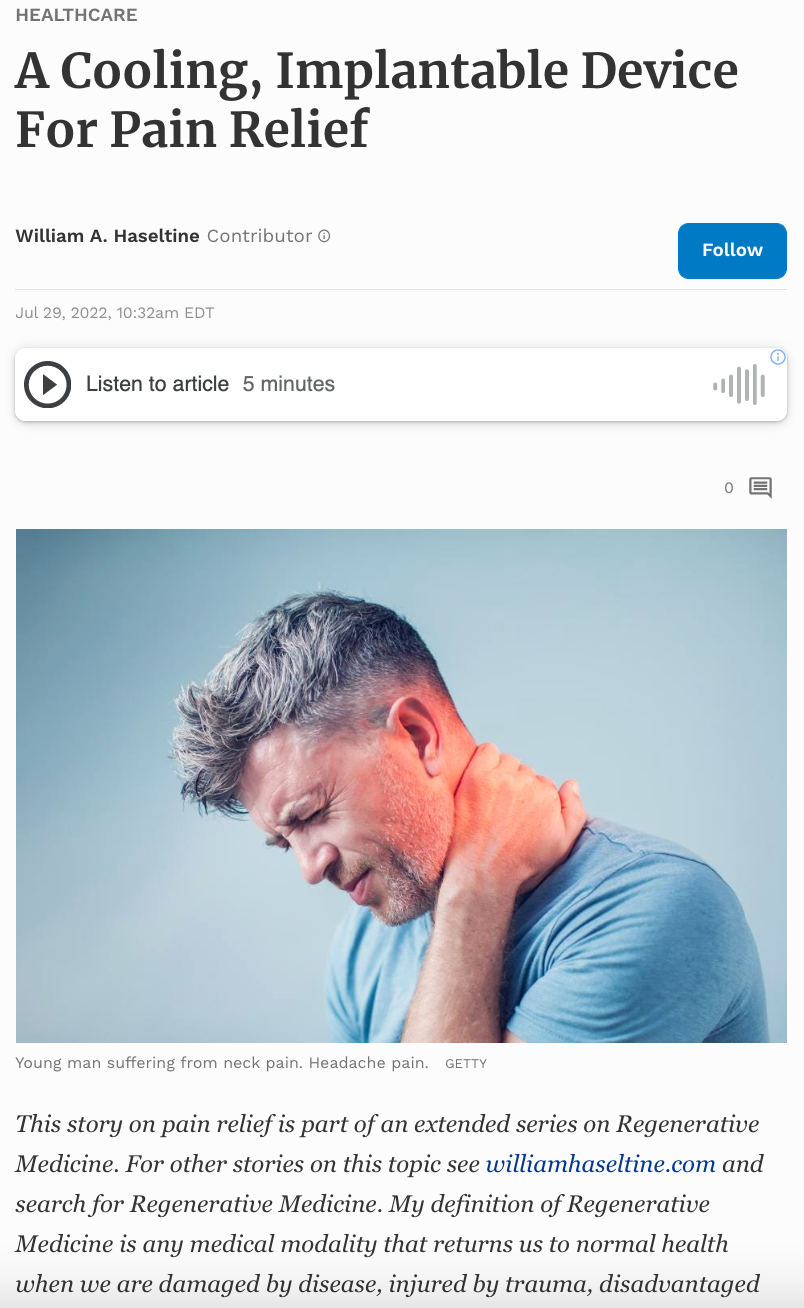This story on pain relief is part of an extended series on Regenerative Medicine. For other stories on this topic see williamhaseltine.com and search for Regenerative Medicine. My definition of Regenerative Medicine is any medical modality that returns us to normal health when we are damaged by disease, injured by trauma, disadvantaged by birth, or worn by time. Modalities include: chemicals, genes, proteins and cells used as drugs, gene editing, prosthetics, and mind-machine interfaces.
Scientists at Northwestern University have recently engineered a new pain-relieving device that uses temperature control to block pain signals to the brain. The device is a small, flexible implant that could serve as a replacement for opioids or other highly addictive medications.
The misuse of opioids is an ongoing crisis in the United States that has only grown since the onset of the Covid-19 pandemic. Despite this, there are very few alternative treatments for pain relief that are as effective, leading to widespread usage of opioids and increased rates of opioid addiction and overdose.
Previous studies have shown that pain signals can be blocked from the brain by using cooling implants that lower the temperature of specific nerves. By decreasing their temperature, researchers can decrease the activity of the nerves and inhibit the release of pain signals. However, cooling implants have historically been bulky, imprecise, and have required additional surgeries to remove once the patient no longer needs them.
Now, in a paper published in the journal Nature, Reeder et al. describes how they developed a new pain-relieving implant that is not only highly precise but can also be absorbed by the body after use, by-passing the need for any extraction surgeries.
To address the challenges of previous cooling implants, Reeder et al. sought to develop a device that would be flexible enough to wrap around specific pain signaling nerves. This would allow the device to be highly precise and target only one nerve at a time. To do so, researchers began by looking at a category of materials called elastomers. Elastomers are very flexible and can be made from plastic, rubber, or resin. They can also be water-soluble, meaning that if a water-soluble elastomer were implanted in the body it would dissolve over time.

But how could an elastomer-based device cool the nerve? Reeder et al. navigated this challenge by taking inspiration from microfluidic systems. A microfluidic system occurs when tiny channels are etched into a material, allowing small amounts of fluid to run through the channels. By incorporating a microfluidic system into the elastomer material, Reeder et al. was able to pass a coolant through the entirety of the implant, ultimately cooling the nerve that the device wrapped around.
After incorporating an additional electronic system within the device so that researchers could track the temperature of the nerve and control how much coolant was pumped through the implant, the device was ready to begin testing in rats.

Researchers successfully implanted the cooling device in rats with leg-based nerve injuries, wrapping the device around their sciatic nerve which controls muscles in the lower body. After cooling down the sciatic nerve for eight minutes, researchers found that activity in the nerve had decreased by 92%. In addition, the amount of time it took for activity to travel through the sciatic nerve was significantly longer. After the device had been turned off and the nerve had returned to normal body temperature, Reeder et al. found that activity had also returned to normal levels.

While more research must be done to determine whether or not the results of this study are consistent in humans, these experiments are promising and suggest that we may be close to developing a new method for pain management. Hopefully, as innovative pain-relief devices continue to be developed, we will not only see the progression of interesting science but also how it may help curb the opioid crisis and limit access to highly addictive medications.


